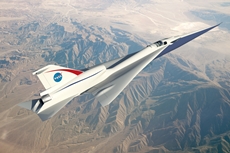Nasa experimenting with next-generation X-planes
25 Apr 2016
The National Aeronautics and Space Administration (Nasa) is in the process of finalising preliminary designs of its new concept, the X-plane, and has test-flown an array of new experimental aircraft known as X-planes that would demonstrate advanced technologies that could push back the frontiers of aviation.
 The first in the series, the Quiet Supersonic Technology, or QueSST, concept is in the preliminary design phase and on its way to being one of Nasa's first X-planes, says a release.
The first in the series, the Quiet Supersonic Technology, or QueSST, concept is in the preliminary design phase and on its way to being one of Nasa's first X-planes, says a release.
Under the 'New Aviation Horizons' programme, announced as part of the US budget for the fiscal year that begins from 1 October this year, Nasa will design, build and fly the series of X-planes during the next 10 years as the US space agency accelerates the adoption of advanced green aviation technologies by industry, the release stated.
The first of the demonstration flight achieved Mach 1 speed - 750 miles an hour – but without breaking the sound barrier.
Then they built a small plane, the X-1, to try to break the sound barrier. The demonstration was carried out at the high desert of California. The names of the test pilots are also under wraps.
Nasa said, over the past seven decades, some the nation's best minds in aviation have been designing, building and flying a series of experimental airplanes to test the latest fanciful and practical ideas related to flight.
These include short wings, long wings, delta-shaped wings, forward swept wings, scissor wings, big tails. no tails, high speed. low speed, jet propulsion, rocket propulsion and even nuclear propulsion – although that technology was never actually flown, Nasa stated.
The manufacturing of these X-planes involver several companies and the planes were operated by a different mix of government organisations for a myriad purposes.
Together they are known as X-planes – or X-vehicles, since some were missiles or spacecraft – and the very mention of them prompts a warm feeling and a touch of nostalgia among aviation enthusiasts worldwide, Nasa said.
''They certainly are all interesting in their own way. Each one of them has a unique place in aviation that helps them make their mark in history,'' said Bill Barry, Nasa's chief historian. ''And they are really cool.''
The X-plane experiments will showcase how airliners can burn half the fuel and generate 75 per cent less pollution during each flight as compared to now, while also being much quieter than today's jets – perhaps even when flying supersonic.
''If we can build some of these X-planes and demonstrate some of these technologies, we expect that will make it much easier and faster for US industry to pick them up and roll them out into the marketplace'' said Ed Waggoner, Nasa's Integrated Aviation Systems Programme director.
In fact, NASA has gone back to the days of its predecessor organisation, the National Advisory Committee for Aeronautics (NACA), and the very first X-plane, fittingly called the X-1, a project the NACA worked on with the then newly formed US Air Force.
Built by Bell Aircraft, the X-1 was the first plane to fly faster than the speed of sound, thus breaking the ''sound barrier,'' which, Nasa said, is ''a popular but fundamentally misleading term that spoke more to the romantic notion of the challenges of high speed flight than an insurmountable physical wall in the sky.''
The X-1 also marked the first in what became a long line of experimental aircraft programmes managed by the NACA (and later NASA), the air force, the navy, and other government agencies.
The X-52 was skipped altogether because no one wanted to confuse that aircraft with the B-52 bomber.
Perhaps of all the X-planes NASA has been associated with, none was more cutting edge and became more famous – rivaling even the X-1 – than the X-15 rocket plane.
''The X-1 was certainly the most historic for being the first and for what it did for supersonic flight. But the X-15 was probably the most productive model of an X-plane,'' Barry said.
Flown 199 times between 1959 and 1968, the winged X-15 reached beyond the edge of space at hypersonic speeds, trailblazing design concepts and operational procedures that directly contributed to the development of the Mercury, Gemini, and Apollo piloted spaceflight programs, as well as the space shuttle.
Another component of the X-15 success story beyond its contributions to high-speed aviation, Barry explained, is that it was a great example of collaboration between NASA, the rival military services of the Air Force and the Navy.
''This kind of major aeronautical research, which the X-15 represented, often is best done when several organizations contribute to a common goal,'' Barry said. ''We're already seeing that as we prepare to fly this next wave of X-planes.''
Some had multiple models using the same number. And still more experimental vehicles were designed, built and flown but were never given X-numbers. And some X-vehicles received numbers but were never built.
Moreover, some X-planes weren't experimental research planes at all, but rather prototypes of production aircraft or spacecraft, further muddying the waters over what is truly considered an X-plane and what isn't, Barry said.
The air force has a current list of 56 X-planes that have been assigned numbers by the Air Force, although actual numbers could be less.







.webp)














